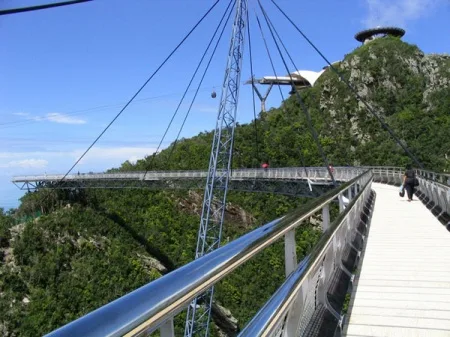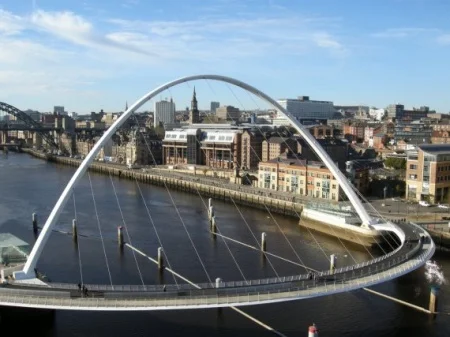Henderson Waves
The 118-foot tall Henderson Waves is Singapore's tallest pedestrian bridge, linking Mount Faber Park with Telok Blangah Hill Park.
Pedestrian bridges allow for a certain amount of creativity that's not possible with structures that need to support heavy-duty use. The undulating outer shell of the Henderson Waves is striking, and the inside is shaped into benches where tourists can sit and gaze at nature or the nearby skyline of Singapore City. The wave-form made up of seven undulating curved steel ribs that alternately rise over and under its deck. The curved ribs form alcoves that function as shelters with seats within. Slats of yellow balau wood, an all-weather timber found in Southeast Asia, are used in the decking.The bridge, which is about 900 feet long, is illuminated by an array of LED lights each night to bolster its snake-like presence in the midst of two national parks.The wave-forms are lit with LED lamps at night from 7pm to 2am daily.
Langkawi Sky Bridge
Set above the treetops, the Langkawi Sky Bridge is one of the highest elevated single-stay bridges in the world. The deck is less than 6 feet wide and its curved shape gives travelers a panoramic view of Langkawi, an archipelago of 99 islands. Each end is fitted with triangular observation decks.
Da Vinci Bridge
Leonardo Da Vinci sketched plans for this bridge in 1502 for Sultan Bajazet II of Constantinople, but it wasn't until 500 years later that the design was brought to life by Norweigan artist Vebjørn Sand. The pedestrian bridge opened in 2001 and crosses the E18 highway.
For centuries it was thought that Da Vinci's sketch of the bridge was implausible. The bowed arches of the single-span design are dramatically thin where they connect with the walkway, but they flare out as they approach the ground. Da Vinci's original plan called for the span to be 720 feet long, but Sand and colleagues scaled it down to 300 feet and built the walkway from Norwegian pine.
Pythonbrug
Design firm West 8 was commissioned to create a series of bridges linking Amsterdam's Sporenburg area with Borneo Island. Pythonbrug, which roughly translates from Dutch as "Python Bridge," opened in 2001 and is about 300 feet long.
The sinuous Pythonbrug is one of the most modern bridges in Amsterdam, a city famous for its traditional canal bridges. Unlike Singapore's Henderson Waves, which relies on an outer shell to create the wave illusion, the Pythonbrug walkway actually dips and rises. While the bridge is certainly an eye-catcher, MacDonald points out that its steep incline wouldn't pass muster under the Americans With Disabilities Act, which sets a 5 percent limit on the grade of such structures.
Gateshead Millennium Bridge
The Gateshead Millennium Bridge is a pedestrian and cyclist tilt bridge spanning the River Tyne in England between Gateshead's Quays arts quarter on the south bank, and the Quayside of Newcastle upon Tyne on the north bank. The award-winning structure was conceived and designed by architects Wilkinson Eyre and structural engineers Gifford.The bridge is sometimes referred to as the 'Blinking Eye Bridge'or the 'Winking Eye Bridge'due to its shape and its tilting method. In terms of height, the Gateshead Millennium Bridge is slightly shorter than the neighbouring Tyne Bridge, and stands as the sixteenth tallest structure in the city.
A system of six hydraulic rams can pivot the bridge's walkway at a 40-degree angle in order to let boats pass. Wilkinson Eyre describes the bridge's movement as looking like a "slowly opening eyelid" when it raises, a process that takes fewer than 5 minutes. Perhaps even more impressive is the fact that the bridge was fully constructed before being installed as a single piece by Europe's largest floating crane, Asian Hercules II.
Slauerhoffbrug
The Slauerhoffbrug (English: Slauerhoff Bridge) is a fully automatic bascule bridge (aka tail bridge) in the city of Leeuwarden in theNetherlands. It uses two arms to swing a section of road in and out of place within the road itself. It is also known as the “Slauerhoffbrug ‘Flying’ Drawbridge”.
The Slauerhoffbrug is a tail bridge that can quickly be raised to allow ships to pass. A tail bridge can quickly and efficiently be raised and lowered from one pylon (instead of hinges). This quickly allows water traffic to pass while only briefly stalling road traffic. It was completed in 2000 and spans a small section of the Harlinger Vaart River.
Instead of rotating open, the Slauerhoffbrug is lifted up by a dual hydraulic system that is built into its pylon. The Slauerhoffbrug is L-shaped, with its foundation sitting adjacent to the road. The deck is 15 m by 15 m. It is painted in yellow and blue, representative of Leeuwarden's flag and seal.





























